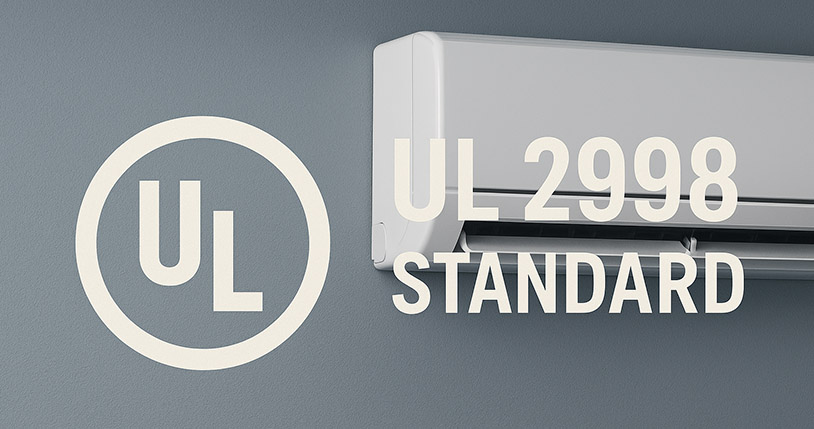When selecting an air purification system, third-party certifications aren’t just labels – they are engineering checkpoints. For engineers, facility managers, and HVAC integrators, understanding these standards can directly impact safety, compliance, and long-term system performance. One certification gaining particular attention in the air purification sector is UL-2998, a validation that directly addresses a key concern in indoor air treatment: ozone generation.
At Air Sniper, safety and compliance are integral to our design philosophy. This article explores what UL-2998 means, why it matters to technical decision-makers, and how Air Sniper aligns with the industry’s most stringent expectations for supplemental air purification systems.
What Is UL-2998? Understanding Zero Ozone Emissions Certification
UL-2998 is a certification from UL Environment that verifies an air cleaning device produces zero ozone emissions during operation. Specifically, a system that passes UL-2998 emits less than 0.005 parts per million (ppm) of ozone – well below the 0.050 ppm allowed under older certifications like UL 867.
Initially developed in response to health concerns surrounding ozone-producing air cleaners, UL-2998 applies to a range of technologies, including ionizers, photocatalytic oxidation units, and UV-C systems. For facility managers operating in healthcare, laboratory, or education settings, this certification offers peace of mind that the air cleaning technology won’t compromise indoor air quality through harmful by-products.
Unlike standard filtration systems, UV-C technologies are often misunderstood in terms of ozone output. Air Sniper’s UV-C systems, however, are engineered with zero-ozone design principles and qualify for UL-2998 validation – making them an optimal solution for high-compliance environments.
UL-2998 vs. Traditional Certifications: Why It Matters
While legacy standards like UL 867 focus on general safety and electrical compliance for air purifiers, they allow for a degree of ozone emission. In contrast, UL-2998 was developed to address growing awareness of indoor air chemistry and occupant safety.
In commercial HVAC environments where airflow recirculates across closed systems, even minimal ozone output can accumulate, impacting both respiratory health and building materials. UL-2998 certification is now being referenced in green building programs like LEED and WELL, and many procurement teams in institutional facilities are making it a standard requirement in RFPs.
By choosing a UL-2998 compliant system like those from Air Sniper, engineers can specify technologies that meet emerging health and safety benchmarks without compromising on performance.
The Risks of Ozone-Generating Air Purifiers
The concern around ozone emissions isn’t hypothetical. Studies by the U.S. EPA and independent laboratories have shown that ozone concentrations as low as 0.1 ppm can irritate the lungs, exacerbate asthma, and degrade indoor materials over time.
OSHA sets an exposure limit of 0.1 ppm over 8 hours, but in poorly ventilated indoor environments, air purifiers that generate ozone may cause cumulative buildup. This is particularly problematic in high-density spaces like schools, hospitals, and cleanrooms – the very environments that depend on continuous supplemental air purification.
Selecting a UL-2998 certified product ensures the air treatment process won’t introduce these risks. Air Sniper’s UV-C technology achieves this by using lamp materials and housing designs that eliminate the production of secondary reactive species.
Air Sniper’s Commitment to Safety and Compliance
At Air Sniper, every system is built for long-term, regulation-compliant operation. Our UV-C units are specifically designed to function without generating ozone or other chemical by-products, aligning with the requirements set forth by UL-2998.
What sets Air Sniper apart is our commitment to supplemental air purification that maintains system integrity and user safety. We achieve this through:
- Zero-ozone UV-C lamps using carefully selected quartz materials
- Thermal stability for operation between -20°C and +100°C
- Extended 6+ year lamp lifespan (55,200 hours)
- Housing components engineered for containment and durability
For regulated sectors – healthcare, pharmaceutical, clean manufacturing – specifying a UL-2998 compliant system is not just a matter of preference; it’s part of a due diligence process. Air Sniper delivers these capabilities with complete transparency and engineering-grade precision.
Engineering Benefits of UL-2998-Validated Systems
For professionals tasked with HVAC design, system integration, or compliance assurance, UL-2998 certification reduces risk on multiple fronts. Benefits include:
- Assurance that the air cleaning technology won’t interfere with indoor air chemistry or VOC-sensitive environments
- Compatibility with ASHRAE 241 design goals for clean air delivery
- Lower regulatory liability under both Canadian and U.S. safety frameworks
Additionally, UL-2998 validated systems provide a reliable benchmark during product selection, especially when assessing multiple vendors in a competitive procurement process.
How UL-2998 Enhances ROI and System Integration
From an investment perspective, the value of UL-2998 extends beyond compliance. Ozone-free operation translates to reduced maintenance needs, longer lifecycle of adjacent HVAC equipment, and improved LEED documentation.
For example:
- Materials degradation caused by low-level ozone is eliminated, protecting duct linings, filters, and sensor systems
- Facility audits and indoor air quality assessments show improved safety scores, reducing remediation costs
- Air Sniper’s modular units integrate seamlessly with BAS platforms, enhancing operational visibility and control
When you choose a system that’s engineered to UL-2998 standards, you’re not just avoiding ozone – you’re improving system longevity and operational performance.
Conclusion: Why Air Sniper Is the Smart Choice
Engineered for compliance, performance, and long-term value, Air Sniper’s UV-C air purification systems meet and exceed the requirements of UL-2998 certification. For engineers and facility managers navigating complex HVAC ecosystems and regulatory demands, Air Sniper offers a proven, non-ozone-producing solution designed for critical environments.
With certified safety, measurable efficiency, and integration flexibility, Air Sniper stands as the trusted option for supplemental air purification systems that prioritize both health and engineering integrity.

